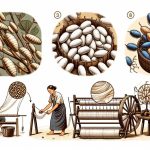In China, India, and the United States, cotton production is most common globally. These countries lead in supplying both domestic and international cotton markets. If you're curious about the detailed global overview and the unique aspects of cotton production in each of these countries, you'll find more fascinating information in the research provided.
Table of Contents
Key Takeaways
- China, India, and the United States are the top producers of cotton globally.
- Pakistan and Brazil also play significant roles in cotton production.
- Uzbekistan, Turkey, and Australia are notable producers contributing to the global supply.
- Cotton is commonly produced in regions like Texas, India, and New South Wales.
- The global cotton supply chain is supported by diverse countries with varying production capacities.
Global Cotton Production Overview
Leading the global cotton production market are China, India, and the United States. These three countries stand out as the top producers in the world, contributing immensely to the global cotton supply.
China leads the pack with an impressive annual output of 6,423,000 tons, solidifying its position as the largest cotton producer globally. India follows closely behind, producing 6,162,000 tons of cotton each year, making it the second-largest producer on a global scale. The United States, with an annual production of 3,181,000 tons, plays a vital role in the cotton production landscape, particularly in the Southern region where cotton cultivation thrives.
These countries not only meet domestic demand but also supply cotton to international markets, shaping the global cotton industry. Their collective contribution highlights the importance of these key producing countries in meeting the world's cotton needs.
China: Leading Cotton Producer
As the largest cotton producer globally, China's annual production of 6,423,000 tons underscores its significant role in the cotton industry.
With over 89 million cotton farmers contributing to the market, China's vast areas suitable for cultivation support its leading position in cotton production.
The implementation of modern technology and agricultural practices further cements China's influence in the global cotton market.
Chinas Cotton Industry
China, as the largest cotton producer globally, annually produces 6,423,000 tons of cotton, playing a pivotal role in the global cotton market. The country's cotton industry is characterized by advanced modern technology utilized in cotton cultivation.
China's significant contribution to the textile industry stems from its expansive cotton farming practices. With a focus on efficiency and high yields, China's cotton sector supports the production of textiles and apparel on a large scale.
The integration of modern techniques and innovation in cotton farming has allowed China to uphold its position as a key player in the global cotton market. This strategic approach guarantees a steady supply of cotton for both domestic consumption and international trade.
Cotton Production Trends
With China's advanced modern technology and vast areas for cotton cultivation, the current trends in cotton production highlight the country's pivotal role in the global market. China leads the world in cotton farming, producing approximately 6,423,000 tons annually.
The country's emphasis on production efficiency through the implementation of modern agricultural practices has greatly boosted its contribution to the global cotton industry. By leveraging technology and sustainable farming methods, China has established itself as a key player in meeting the increasing demands for cotton worldwide.
The continuous growth and development of cotton production capacity in China underscore its position as a dominant force shaping the trajectory of the global cotton market.
Indias Significant Cotton Contribution
India plays a major role in the global cotton production landscape as the second-largest producer, annually harvesting 6,162,000 tons. The country's historical and cultural connection to cotton, often referred to as the birthplace of the crop, highlights its importance in the textile industry.
India's cotton sector is a vital component of its economy and agricultural domain, contributing greatly to both domestic consumption and international trade. With the potential to surpass China in cotton production, India stands as a key player in the global cotton market.
The cotton industry in India not only supports the textile sector but also provides employment opportunities and sustenance to many rural communities. This substantial production volume underscores India's pivotal role in meeting the world's cotton demands, showcasing its influence and impact within the global cotton industry.
United States: Major Cotton Producer
I'll discuss the US cotton industry and the top cotton-producing states in the country.
The United States is a significant player in the global cotton market, producing over 3 million tons of cotton annually.
States like Texas drive this production, utilizing advanced tools and technology to meet both domestic demand and international needs.
US Cotton Industry
The US Cotton Industry thrives as a major player in the global cotton production market, annually yielding 3,181,000 tons of cotton. The United States, with its vast Cotton Belt region, is a key contributor to the worldwide cotton production.
Utilizing advanced tools and technology, the U.S. maintains high levels of cotton production to meet the demand primarily driven by the textile industry. The historical significance of cotton cultivation in the Southern U.S. has established the country as a prominent figure in the cotton farming sector.
Despite its substantial production capacity, the U.S. still imports cotton to fulfill the domestic requirements for various cotton-based products, showcasing the intricate balance between production and consumption in the industry.
Top US Cotton States
Among the diverse states contributing substantially to the United States' cotton production, Texas stands out as the largest cotton-producing state.
Texas plays a pivotal role in the country's cotton industry, with its vast agricultural lands dedicated to cotton cultivation.
Additionally, states like Georgia, Mississippi, and Arkansas are also leading producers of cotton, with a rich history in the cotton trade.
California and Arizona are remarkable for their adoption of advanced farming techniques, further boosting U.S. cotton production.
The Southern region, often referred to as the 'Cotton Belt,' has been a traditional powerhouse in cotton production, with states such as Alabama and Louisiana also making significant contributions.
These states are increasingly embracing modern technologies and sustainable practices to enhance cotton production efficiency and promote environmental sustainability.
Pakistans Role in Cotton Production
Playing an important role in the global cotton market, Pakistan maintains its position with a steady growth rate in cotton production. The country, known for its consistent output, is expected to witness a modest increase of approximately 2% in cotton production in the upcoming year.
Despite encountering challenges in scaling up production levels, Pakistan remains a vital player in the worldwide cotton industry. Pakistan's cotton sector not only supports the textile industry but also contributes greatly to the economy.
Brazils Growing Cotton Industry
I've noticed a remarkable growth in Brazil's cotton industry, with production doubling in just four years, making it one of the top cotton exporters globally.
Despite challenges like the pandemic, Brazil's focus on non-irrigated cultivation has been a key driver for its significant expansion in the cotton market.
This growth not only showcases Brazil's production capacity but also highlights its resilience and positive impact on the economy.
Brazils Cotton Expansion
In the last four years, Brazil has demonstrated remarkable growth in its cotton industry by doubling its production, positioning itself as a significant player in the global market.
Despite challenges like the pandemic, Brazil has expanded its cotton industry, becoming the world's second-largest cotton exporter. The country mainly practices non-irrigated cotton cultivation, showcasing its efficient farming methods.
Brazil's increased production capacity has solidified its position as a key player in the global cotton market. While facing obstacles such as climate variations and market fluctuations, Brazil's cotton industry continues to exhibit growth potential and competitiveness.
The country's strategic advancements in cotton production highlight its increasing importance in the international cotton trade landscape.
Factors Driving Growth
Amidst Brazil's growing cotton industry, key factors are propelling its remarkable expansion in the global market. Brazil has doubled its cotton production in the last four years, solidifying its position as the second-largest cotton exporter worldwide.
Despite the challenges posed by the pandemic, Brazil's cotton industry has witnessed significant growth, particularly in non-irrigated cotton cultivation. The country's increased production capacity has positioned it as a major player in the global cotton market.
This growth not only demonstrates Brazil's potential for further expansion but also highlights its substantial contribution to the industry. Looking ahead, Brazil's cotton industry is projected to sustain its upward trajectory with a modest anticipated increase of 2% in the coming year.
Uzbekistans Cotton Production Landscape
Amid controversies surrounding forced labor, Uzbekistan's cotton production landscape stands as a cornerstone of the country's economy. Uzbekistan is one of the largest cotton producers globally, with cotton production playing a significant role in its economic structure.
However, the country's cotton sector has faced criticism and scrutiny due to issues related to forced labor. The Uzbekistan cotton industry is state-controlled, with a history of government involvement in the production process.
Cotton cultivation in Uzbekistan is primarily carried out through state-owned farms, further emphasizing the central nature of the industry. These state-owned farms have been at the center of debates regarding the use of forced labor in cotton harvesting.
Despite the controversies surrounding forced labor, the cotton sector remains crucial to Uzbekistan's economy, highlighting the complex dynamics between economic development and social issues within the country.
Turkeys Cotton Farming Sector
Considering the importance of cotton production landscapes in various regions, the spotlight now shifts to Turkey's Cotton Farming Sector, a key player in Europe's cotton industry. Turkey holds the title of being the largest cotton producer in Europe, with a primary focus on high-quality, long-staple cotton varieties.
The country's cotton farming activities are primarily concentrated in the Aegean and Southeastern Anatolia regions, contributing greatly to the agricultural sector. Over the years, Turkey's cotton sector has embraced advancements in technology and sustainable farming practices, ensuring both efficiency and environmental responsibility.
The sector's emphasis on quality has helped Turkey maintain a strong position in the global cotton market. As an essential component of the country's agricultural landscape, cotton farming in Turkey continues to play an important role in driving economic growth and supporting local communities.
Australias Cotton Output Statistics
Australia stands as the 4th largest global cotton producer, with a significant presence in the industry. The Australian cotton industry is an essential component of the country's agricultural sector, boasting high-quality cotton and sustainable farming practices.
Here are some statistics regarding cotton production in Australia:
- Concentration: Cotton production in Australia is primarily concentrated in the states of New South Wales and Queensland, where ideal climate conditions support the growth of this crop.
- Production Volume: In the 2019-2020 season, Australian cotton production reached around 2.5 million bales, highlighting the significant contribution of the country to the global cotton market.
- Economic Impact: The cotton industry in Australia plays a pivotal role in the country's agricultural economy, providing employment opportunities and contributing to the overall economic growth.
- Quality Assurance: Australia's cotton output is renowned for its high quality, meeting stringent standards, and reflecting the commitment of Australian farmers to sustainable and ethical farming practices.
Other Notable Cotton Producing Countries
Brazil has recently doubled its cotton production, positioning itself as the second-largest cotton exporter worldwide. This surge in output has solidified Brazil's position among the top cotton producers globally.
Pakistan, another prominent player in the cotton industry, has been facing challenges in increasing its growth rate despite maintaining consistent production levels.
China, the largest cotton producer globally, annually yields around 6,423,000 tons of cotton, playing a pivotal role in the global cotton market.
India follows closely behind as the second-largest cotton producer, producing 6,162,000 tons annually, with a rich historical connection to cotton as its birthplace.
The United States of America also contributes significantly to the cotton production landscape, producing 3,181,000 tons yearly, with a focus on the Southern region due to high demands for textiles and advanced cultivation techniques.
These countries collectively shape the landscape of global cotton production, with Brazil emerging as a notable contender and China holding the title of the largest exporter.
Frequently Asked Questions
Where Is Cotton Mostly Produced?
Cotton production centers around countries like China, India, and the United States. China leads globally, with India following closely. The U.S., particularly the Southern region, also plays a significant role due to high textile demand.
In Which State Cotton Is Produced Most?
In the United States, Texas leads in cotton production. Its vast agricultural land and favorable climate contribute to this. Georgia, Mississippi, and Arkansas also play significant roles. The Southern region, historically dominant, sees Texas at the forefront.
Why Is Most of the Cotton Grown in the United States?
Most of the cotton is grown in the United States due to the historical significance of the Southern region's climate and soil for cotton cultivation. Economic shifts and soil quality changes have influenced the shift to other crops.
What Climate Does Cotton Grow In?
Cotton thrives in tropical and subtropical climates with warmth, sunlight, and well-drained soil. It needs temperatures between 60-95 degrees Fahrenheit, a long frost-free period for 160-200 days, and sufficient moisture for successful growth.
- Why Is Red Velvet Not Red? - April 25, 2024
- How Do You Describe Velvet Fabric? - April 25, 2024
- How Strong Is Velvet? - April 25, 2024






